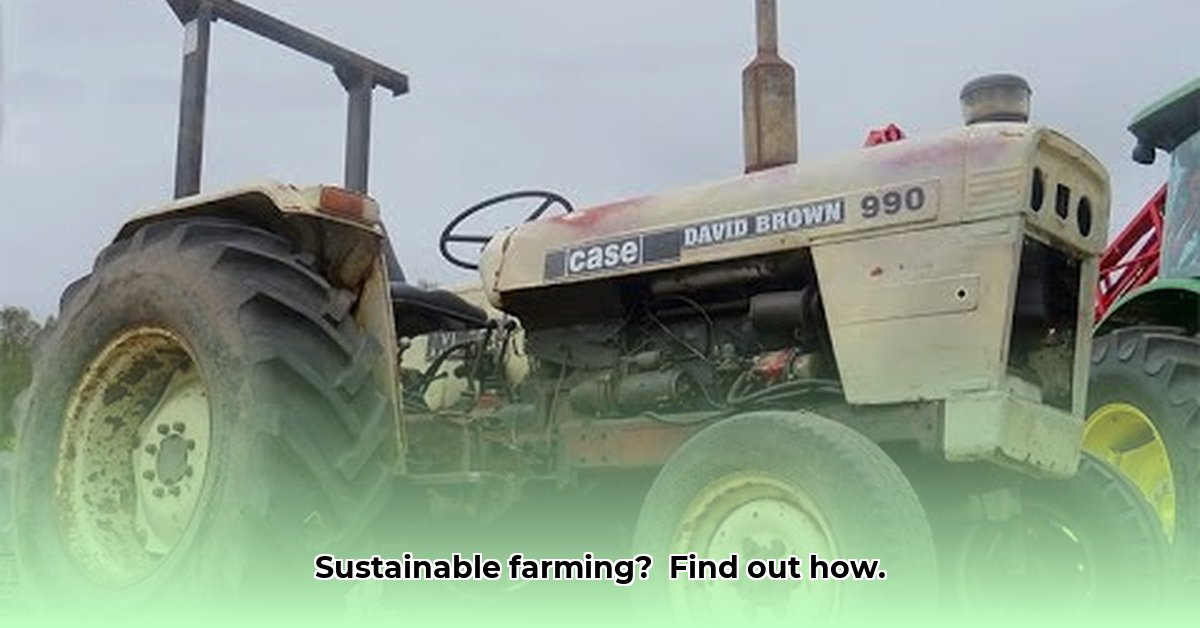
Brown Tractor: Your Guide to Sustainable Farming Choices
Choosing the right farm equipment is a significant decision, particularly for farmers committed to sustainable agriculture. This article analyzes Brown Farm Equipment's practices, highlighting both strengths and areas for improvement in their contribution to environmentally friendly farming. We'll examine their equipment's longevity, discuss the importance of transparent inventory management, and offer actionable insights to improve their sustainability profile. For more information on tractor costs, see this helpful resource: Tractor Costs.
Brown Tractors: A Detailed Look at Their Practices
Brown Farm Equipment is known for producing durable, reliable tractors, earning the trust of farmers for years. Their pre-purchase equipment inspections are a commendable practice, minimizing early failures and reducing waste. This focus on quality and longevity directly contributes to sustainability: fewer breakdowns translate to lower fuel consumption and reduced replacement part needs. The practice of storing tractors indoors during harsh winters further extends their lifespan—a smart, environmentally conscious strategy.
However, accessing detailed information about Brown tractors' environmental impact presents a challenge. Their current inventory system lacks user-friendliness, hindering farmers' ability to quickly assess the sustainability features of various models. This lack of readily available information is a significant concern. Key questions remain unanswered: What percentage of recycled materials are used in manufacturing? What types of lubricants (and their environmental impact) are used during maintenance? Where do their parts originate? Addressing these concerns is paramount for building trust with environmentally conscious consumers.
Transparency is crucial for sustainable agriculture. Farmers need to understand the lifecycle of their equipment—from sourcing materials to manufacturing and ongoing maintenance. This informed approach empowers them to make conscious choices aligned with responsible farming practices.
Enhancing Brown Farm Equipment's Sustainability Profile: Actionable Steps
Brown Farm Equipment can significantly enhance its sustainability profile through specific, targeted actions:
Develop a comprehensive, user-friendly online inventory: This should include detailed specifications, material sourcing information, and manufacturing processes for each tractor model. (This allows customers to make informed choices based on their environmental priorities.)
Implement transparent sustainability reporting: Publicly disclose their sourcing practices, the materials used, and their manufacturing processes. (This builds consumer trust and promotes accountability.)
Prioritize the use of recycled materials and eco-friendly manufacturing processes: Actively pursue sustainable manufacturing practices throughout their supply chain. (This reduces the overall environmental impact of their products.)
Publicly share lubricant choices and maintenance procedures: Detailed information on the environmental impact of their lubricants and maintenance protocols will strengthen their sustainability credentials. (This allows farmers to evaluate the long-term environmental consequences of their purchasing decision.)
Risk Assessment: Navigating Potential Challenges
Even with well-intentioned practices, challenges may arise. Here’s an assessment of potential risks associated with Brown Farm Equipment's current operational practices:
| Risk Factor | Likelihood | Impact | Mitigation |
|---|---|---|---|
| Difficulty Accessing Inventory Information | High | Medium | Develop a user-friendly, detailed online inventory system. |
| Lack of Transparency Regarding Sourcing | Medium | High | Publicly disclose complete sourcing practices and materials used in manufacturing. |
| Uncertainty about Maintenance Practices | Medium | Medium | Clearly communicate maintenance procedures and the environmental impact of materials used. |
| Potential for Bias in Operational Checks | Low | Low | Implement standardized, objective assessment criteria for equipment inspections. |
These risk assessments are based on currently available data. Further investigation and more comprehensive data could refine these estimations.
Sustainable Farming: A Long-Term Vision
Investing in sustainable farming is essential for the future of our food systems and planet. Brown Farm Equipment has taken positive initial steps by focusing on equipment longevity. However, increased transparency is crucial for strengthening their commitment to sustainable agriculture. By providing readily available information on their practices, they can empower farmers to make informed choices that benefit both their operations and the environment. The goal is to transform selecting a Brown tractor from a leap of faith into a confident step towards a greener future. What better way to demonstrate a commitment to sustainability than full transparency?
How to Find Sustainable Used Farm Equipment with Transparent Maintenance Records
Finding sustainable used farm equipment requires diligence. This section provides a step-by-step guide.
Key Takeaways:
- Purchasing used farm equipment offers significant cost and environmental benefits.
- Thorough due diligence is crucial for successful and sustainable procurement.
- Diverse sourcing options exist, each presenting unique risks and rewards. Careful inspection is paramount.
- Proactive maintenance planning significantly extends equipment life.
- Transparent maintenance records are indispensable for genuine sustainable practices.
A Step-by-Step Guide to Sustainable Used Equipment Acquisition:
Assess Your Needs: Define your requirements (equipment type, budget). This focused approach streamlines your search.
Source Sustainably: Explore multiple avenues—online marketplaces, local auctions, farm networks. Thoroughly vet sellers: check ratings and reviews.
Prioritize Transparent Maintenance Records: Request detailed service logs documenting all repairs and maintenance. These records are crucial for assessing the equipment’s history and reliability.
Conduct a Hands-On Inspection: A personal inspection, ideally with a trusted mechanic, is non-negotiable. Thoroughly test all functions and check for wear and tear.
Negotiate and Finalize the Purchase: Negotiate fairly, considering any identified issues. Secure all necessary documentation for legal protection.
Implement Proactive Post-Purchase Maintenance: Establish a regular maintenance schedule. This prevents costly repairs, extends the equipment's lifespan, and minimizes environmental impact.
Source Replacement Parts Sustainably: Prioritize suppliers committed to using recycled or reused materials. Supporting these suppliers contributes to a circular economy.
Remember, sustainable farming encompasses more than just equipment; it's about building lasting, responsible practices.